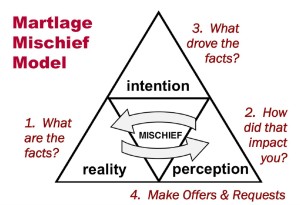Giving feedback has never been something that I can do easily. It is not that I don’t have an opinion on subjects, more than likely I feel that it is not important for the other person to receive it. When things get so big that I believe that there is benefit on expressing my opinions more than likely I will try to either schedule a meeting or write an email. By that point I have stung together so many things that the message probably feels like I go bonkers over petty things. It is hard to express that the accumulation of it all is the cause, and most meeting end with: “You should have told me sooner that those things were bothering you.”
Over the past 4 months I’ve been meeting with consultants that are helping my team develop stronger relationships as we deploy a new business process in our business unit. One of the traits I chose to improve was the way I give feedback. Although this journey was hard for me, I’m sure that it is incredibly easy for others; but if you are in my camp they you understand.
Thinking about feedback I started remembering a trip I took with my family to Sea World. Looking at the magnificence of the whales and their interaction with their trainers I started remembering the cues and feedback these animals receive as they do what they are told to do. I think I always thought that was the only feedback needed, encouragement on the things we do well, but we are no animals and as humans we want to improve on the things we are lacking.
I didn’t have a way to effectively give feedback, I thought that I should meet and have this laundry list of things and we could all just mark each of the items off. I’ve learned a few ways to give feedback that allow both parties to come out of it positively.
 First is the XYZ Sandwich, which I learned is an easy way to express behaviors. Read the link, it explains what it is, for me what it meat was that I had now a structure, a script that I could use to express my ideas. For someone who didn’t even know which words to pick, this was a great help. I was still uncomfortable with just saying this phrase to a coworker as things happened, but I could connect with them after I had written down what I wanted to say and just express my ideas. What happened was that people would improve or I would find out more information about their motivations and perspective.
First is the XYZ Sandwich, which I learned is an easy way to express behaviors. Read the link, it explains what it is, for me what it meat was that I had now a structure, a script that I could use to express my ideas. For someone who didn’t even know which words to pick, this was a great help. I was still uncomfortable with just saying this phrase to a coworker as things happened, but I could connect with them after I had written down what I wanted to say and just express my ideas. What happened was that people would improve or I would find out more information about their motivations and perspective.
 Another tool that I’ve learned comes from Ken Martlage from the group Phoenix Images. From this I was able to understand that before giving feedback I needed to separate reality (facts) from my perception. When my perception is incorrect I can attribute the wrong intentions for why people were doing things. Having understood this I now could talk to someone and discuss each angle separatly: (1) what are the facts? (2) how did these actions impact me? (3) what drove the facts? (4) what am I requesting? what am I offering?
Another tool that I’ve learned comes from Ken Martlage from the group Phoenix Images. From this I was able to understand that before giving feedback I needed to separate reality (facts) from my perception. When my perception is incorrect I can attribute the wrong intentions for why people were doing things. Having understood this I now could talk to someone and discuss each angle separatly: (1) what are the facts? (2) how did these actions impact me? (3) what drove the facts? (4) what am I requesting? what am I offering?
The final piece in this journey is doing it. You have the tools, now pick something that you feel someone needs to improve and take a stab at their intentions. Words like: “you probably wanted X…” or “I guess your intention was Y…” and finally propose an alternative. Write these things down on a piece of paper, also do an assessment on yourself and offer possible alternatives on behaviors you should improve.
The first time I did this I was really scared, I couldn’t believe I was asking a colleague if they wanted my input on their performance. This colleague had been struggling in a few meetings and I felt that I needed to help them out, but we weren’t as close that I could just say: “hey, they really put you through the ringer; next time you should do this…” I was also being assigned tasks my boss thought I could tackle better than them. So I sent them a note that just said: “How are you feeling about all this pressure? I have a few suggestions that could help you improve. Do you have time on Friday to go over them?” My colleague agreed and we met. I had my notes in front of me and we just had a conversation. For some intentions I had them wrong, others were on point. At the end we ended the meeting on a high note, higher than what I would have anticipated. We had a higher level of trust and a deeper respect one for the other.
I had read an article in the HBR Blog about negative feedback. The authors show that employees want that negative feedback, even more than the positive praise. I guess in my n=1 this was also true, and it felt good.

